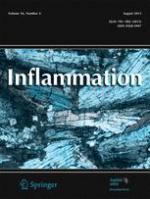Citation:
Ginsburg I, Borinsky R, Lahav M, Gillert KE, Falkenberg S, Winkler M, Muller S. Bacteria and zymosan opsonized with histone, dextran sulfate, and polyanetholesulfonate trigger intense chemiluminescence in human blood leukocytes and platelets and in mouse macrophages. Inflammation. 1982;6 (4) :343-364.

Abstract:
Human blood leukocytes and platelets and mouse peritoneal macrophages emit very rapid and very intense Luminol-dependent chemiluminescence (CL) signals when treated with streptococci, staphylococci, or with zymosan, which have been preopsonized with arginine-rich histone, dextran sulfate or polyanetholesulfonate (liquoid). Liquoid alone at 10-30 micrograms/2 X 10(5) leukocytes also triggers intense CL responses in the absence of a carrier. Strong CL can also be triggered, and at the same levels, when the various polyelectrolytes are simply mixed with the bacteria or zymosan and added to the leukocyte suspensions. The CL responses induced by the polyelectrolyte-bacteria complexes greatly exceed those triggered in leukocytes by antibody-complement-coated particles. Liquoid also shows a unique property of markedly augmenting CL signals which have already been induced by other ligand-coated bacteria or zymosan particles. Streptococci and staphylococci were found to be much superior to zymosan, Gram-positive bacilli, or E. coli as carriers for the various polyelectrolytes in the CL reaction. Neither protamine sulfate, lysozyme, myeloperoxidase, crystalline ribonuclease (all cationic in nature), chondroitin sulfate, heparin, nor alginate sulfate acted as ligands for triggering CL, when used to opsonize bacteria or zymosan. The induction of CL in blood leukocytes by the various ligand-coated bacteria is markedly inhibited by azide, KCN catalase, aminotriazole, and EDTA, agents known to inhibit the production of oxygen radicals following stimulation of leukocytes by opsonized bacteria. Two children diagnosed for chronic granulomatous diseases (CGD) of childhood and an apparently healthy sister of one of the male patients completely failed to respond with CL either to the polyelectrolyte-bacteria complexes, liquoid or antibody-coated bacteria and zymosan. It is proposed that liquoid be employed for the rapid screening of defects in certain oxygen-dependent metabolic processes in both PMNs and macrophages. It is also suggested that polyelectrolytes like the ones described in this study may markedly enhance the bactericidal properties of leukocytes and macrophages towards both extracellular and intracellular microorganisms and may perhaps also augment the tumoricidal effects of activated macrophages.Publication Global ID: http://www.ncbi.nlm.nih.gov/pubmed/6186606

